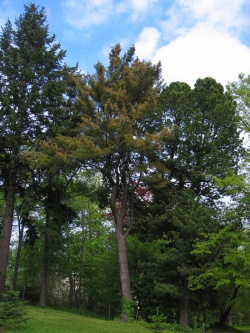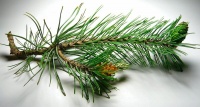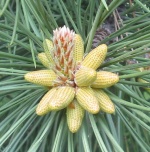Pinaceae
| Pinaceae |
|---|

|
| Scientific Classification |
|
| Genus |
|
Subfamily Pinoideae
Subfamily Piceoideae
Subfamily Laricoideae
Subfamily Abietoideae
|
Pinaceae is a taxonomic Family of cone-bearing trees (conifers). They are found mostly in the Northern Hemisphere, and are comprised of 11 genera and up to 250 species. The subfamilies of Pinaceae include the Pinoideae, Piceoideae, Laricoideae, and Abietoideae.
Trees that belong to the Pinoideae have cones with a distinct seasonal growth, and scales with a broad base. Trees that belong to the Piceoidae have cones without an umbo and the seeds are black with no resin on the seed. The cones of the Laricoideae subfamily also have scales with a broad base, but seeds that are whitish, firmly fixed to the seedwing. These have no resin vesicles attached to the seeds. Finally, the cones observed from the Abietodoideae subfamily have scales with a narrow base. The seeds are brown, but what makes it distinct is that unlike others, there is no micropylar fluid in these trees. A general description of this family of trees would include a height of 2 to 100 meters tall, mostly evergreen, resinous, spirally scales, and two winged seeds on each scale.
Anatomy
Pine-bearing trees that belong to the Pinaceae family are rarely shrubs, and have the anatomy that is distinct. The bark is usually smooth or scaly, and the branches are either leading or short/dwarf shoots. The internodes between leaves are about 1 cm apart, and they are rather simple. Usually, they are needle-like, fascicled, or spirally on shoots. Resin canals are present on shoots, and cones mature in 1 season. The scales found on the cones overlap, spirally arranged, and although thin, they are woody and strongly thickened upon maturing. The cones themselves shed annually if they are pollen cones, and they may be either solitary or clustered. Seeds account two per scale.
Reproduction
Female cones are also called macrosporangiate strobili, where male cones which are pollinated, are also called microsporangiate strobili. 10 genera are distinguishable by morphological characters that have reproductive structures. The reproduction can also be simply observed through the pollination of the male and female species. Pollen is moved into the pollen chamber in the apical part of the nucellus. The movement or method of reaching effective pollination is through rainwater. The pollen of Pinaceae has five cells at maturity, and the process of mitosis can clearly be observed throughout the stages.
Ecology
The Pinaceae family can be found on a broad range throughout the Northern Hemisphere from the south to the West Indies, Central America, Japan, China, Indonesia, the Himalaya, and North Africa. The Pinaceae family is dominant in the forests of North America, and the forests of the Pacific Regions. They thrive in various climates from warm temperatures to even the Arctic Circle, from sea level to alpine habitats 4,800 meters above sea level as seen in Tibet. Members of this family of trees provide cover for many wildlife species and are important for the diets of many animals such as birds, squirrels, and chipmunks.
References
Gallery
Douglas-fir
(P. menziesii)
Genus: PseudotsugaLoblolly pine
(P. taeda)
Genus: PinusBlue spruce
(P. pungens)
Genus: PiceaJapanese red pine
(P. densiflora)
Genus: Pinus







